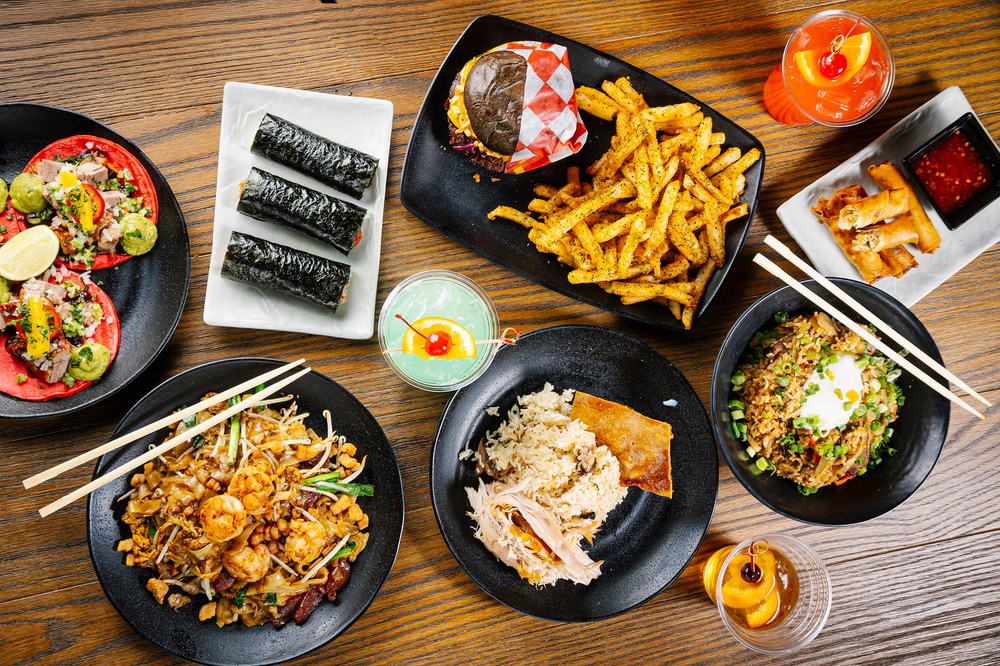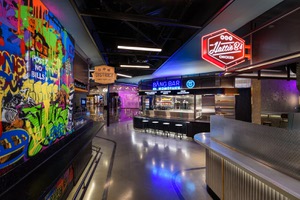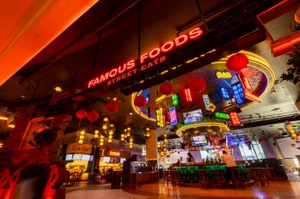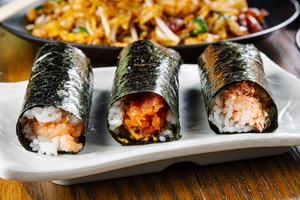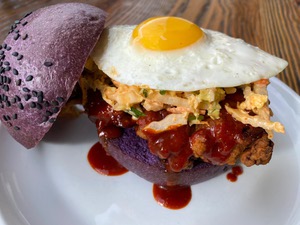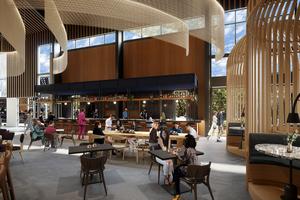Variety always has been the spice of life when it comes to Las Vegas casino cuisine, or at least since the city’s earliest gambling halls began to morph into something greater.
“Gourmet” dinner theater venues and casual coffee shops quickly gave way to all-you-can-eat buffets, hearty steakhouses and more refined seafood, Asian and Italian restaurants. The arrival of the modern Vegas megaresorts in the ’80s and ’90s took fine dining in the desert to new heights, and the decades that followed elevated casual cuisine and diversified with specific flavors from around the world.
One of today’s most exciting food trends combines the different elements that have shaped the Vegas dining scene through the years, and these new venues are equally attractive to locals and tourists. The recent and current generation of food halls are creative, convenient and communal, and most importantly, the flavors always deliver.
At Resorts World, the newest megaresort on the Strip, the most celebrated dining experience is Famous Foods Street Eats, a hi-tech version of a Singapore-style hawker center, with 17 different vendor stalls serving pan-Asian and other fare, including a handful of Michelin Bib Gourmand-rated street kitchens. At the Cosmopolitan, the always-bustling Block 16 Urban Food Hall continues to bring beloved bites from Nashville’s Hattie B’s Hot Chicken and Portland sandwich mecca Lardo, among other carefully curated options.
Newly opened at Aria, the Proper Eats Food Hall blends acclaimed restaurants from across the country with new homegrown concepts. And Downtown, the Fremont Hotel has assembled an intriguing mix of familiar brands and local operators at its new casual dining destination. Everyone is getting in on the act, including the blossoming mixed-use UnCommons development in the southwest valley.
You can’t really understand what all the fuss is about until you’ve experienced it. So let’s dig into the Las Vegas food hall phenomenon and prepare you to gather your hungriest companions and enjoy every bite.
The Difference
The idea of putting smaller versions of different restaurants together in one space with a shared dining room is not a new one. Las Vegas shopping malls, casinos and convention centers have been doing it forever. So what makes a food hall so much more interesting than a food court?
“Historically, when you look at food courts at malls or shopping centers, you find more mass-market, publicly traded companies [restaurant chains], and there was a cookie-cutter approach to how they operate,” says Bryan Fyler, vice president of food and beverage at the Cosmopolitan. “When you look at Block 16, it’s [about] really getting together, picking things that are new to the market and what is satisfying to multiple palates. And it’s [creating] a dining destination where you bring a group—not everyone wants to eat the same thing, so you can branch out and then come together in a communal setting to enjoy a meal.”
Located on Cosmo’s second level near Marquee Nightclub, Block 16 opened in fall 2018 with six first-to-market, chef-driven, made-to-order dining concepts. Fyler was a member of the team that scoured the country to curate each vendor; in addition to Hattie B’s and Lardo, they picked New Orleans’ District Donuts, New York City’s tequila and mezcal bar Ghost Donkey, Portland’s Pok Pok Wing, and local restaurateur Takashi Segawa’s sushi Tekka Bar. Everything was slightly edgy and completely delicious, and the intimate, urban setting made eaters feel like they were in the middle of the coolest, tastiest party in town.
“Our clientele [at Cosmo] is well-traveled. Our guests are aware, they understand different cuisines and concepts and they’re also curious to try something they haven’t had the opportunity to try,” Fyler says.
Simply put, it’s all about the food. That collection of Sbarro, Panda Express and Hot Dog on a Stick you remember from your teenage mall-hopping days was built for convenience—recognizable variety at low prices in an environment not necessarily designed as a social spot. The much more thoughtful food hall is a legitimate culinary experience, even if it’s still serving burgers and fries, and the various vendors are chosen to complement each other and enhance overall guest satisfaction.
Here in Las Vegas, they’re typically organized and operated by a single company, even if other brands and concepts are collaborating under one umbrella. Clique Hospitality, founded by nightlife and hospitality legend Andy Masi, was brought in by MGM Resorts to create the Proper Eats experience, which opened around the first of the year.
“Aria is one of the better food hotels on the Strip … but one of the things they were missing was a little bit more of a casual experience,” says Jason McLeod, the food hall’s culinary director. “It was important to give the guests something that they could get quick, easy, delicious, tasty, but keeping with the Aria design and feel.”
The Evolution
Proper Eats is the latest Strip experience (see sidebar), and it’s easy to see why Aria would convert its former buffet space into a shiny new example of the food hall trend. Vegas visitation is becoming a more diverse group as the years roll along, different ages and lifestyles coming from different places, seeking out unique experiences.
While Block 16 gets credited for setting the standard, Caesars Entertainment might have kick-started the trend by opening the Fulton Street Food Hall at Harrah’s Las Vegas in 2014. That expansive venue split the difference between buffet and food court, with several made-to-order food stalls among many options: pizza, deli sandwiches, beer and wine, tacos, burgers, noodles and tons of desserts. Everything falls under the Fulton Street banner; there are no imported concepts, but the quality is a significant step up from casino courts of old.
The Cosmo changed the game, and changed up its offerings slightly when celeb chef David Chang’s Bāng Bar replaced Pok Pok Wing at Block 16.
Months after that 2018 opening, Eataly Las Vegas debuted at Park MGM, the comprehensive Italian food and wine marketplace experience known throughout the world. While it contains two sit-down restaurants, the Vegas version’s Cucina del Mercato certainly qualifies as a food hall, with its selection of counters and bars and vibrant central seating area, where you should first stake out a table before roaming a sea of pasta, pizza, sandwiches, seafood, Italian street foods and the butcher and salumeria stations.
Next came Famous Foods Street Eats when Resorts World opened in 2021, a collaboration between the resort, the Zouk Group and individual vendors from Asia and the U.S. It offers Michelin Guide-recognized Shanghainese dumplings from Ah Chun Shandong, Blood Bros. BBQ from Texas, Hainanese chicken rice from Boon Tong Kee, and legendary lechon from Pepita’s Kitchen, to name a few.
“We wanted to bring these hawkers from southeast Asia, the people that started cooking from carts on the streets, and bring that authenticity to Vegas and have everything under one roof,” says Resorts World Executive Chef Devin Hashimoto. “It was challenging in the beginning, given what we were going through in 2020. There were a lot of Zoom calls and sharing recipes and emailing to connect with them.
“It was definitely something new for me,” Hashimoto continues, “doing video calls with the [people behind] Springleaf Prata Place to learn to make prata, the bread, and all the techniques that go into making the dough, stretching it, wacking it on the board, and they’re watching us on video on Teams.”
Bringing so many different vendors together to launch something new during the pandemic was a feat by itself, but staying true to the food at each kiosk was the real accomplishment.
“We had to decide which items to put on the menu, focus in and do it right. At Googgle Man, there’s two dishes—that’s it—but you have to perfect them every single time,” Hashimoto says. “There’s always discussion about having enough ‘dragon’s breath,’ the smoke that comes off the wok, in the char kuey teow noodles. It gives the dish its character, that smokiness.”
Many of the dishes at Famous Foods aren’t available anywhere else in Las Vegas, but there’s another element that makes the Resorts World food hall a pivotal development. Instead of ordering your food at each individual stall, you can order anything at any touchscreen in the area. Then you pay and receive a text message when your food is ready. The technology creates a different experience, and while it took time for some guests to adjust, the process has further distinguished the venue.
“We got to the point where it’s running great, and … guests enjoy it and we get a lot of great feedback because it’s something new,” Hashimoto says. “There are people like me who don’t want to see a picture of the food onscreen, I want to see what the cooks are doing. And you see guests walking around stall to stall, or walking the entire area, and then they get five dishes so they can have a little bit of everything.”
Conversely, Block 16 tinkered with tech and decided to simplify its process. “We wanted to maintain interaction where you are walking up and speaking to a person who cares about you, your order and your experience in that moment,” Fyler says. “When we first opened, we thought we might be high volume, very transactional, and then understood this is a chef-driven food hall, a hospitality experience, so we keep working to continuously evolve that.”
The Future
By bringing a very specific cultural experience from the other side of the world and scaling it up Vegas-style, Resorts World has made a major impact on Strip dining. The next wave of Vegas food halls is happening off the Strip.
The 13,000-square-foot Fremont Food Hall opened in mid-December at the iconic Downtown casino, and don’t let the presence of the ubiquitous doughnut slingers at Dunkin’ or Midwestern burger fave Steak ’n Shake throw you. This isn’t some old-school food court. Bringing balance are Roli Roti, the San Francisco rotisserie chicken food truck founded by a Swiss butcher; the first Vegas location of Huey Magoo’s Chicken Tenders, from Orlando; the second spot from beloved local bakery and café CraftKitchen, from chef Jaret Blinn; and a new spot for Tomo Noodles, the Asian eatery that previously served ramen, saimin, poke nachos and more at Village Square near Summerlin.
The next massive food hall won’t even be inside a casino. The Sundry, an collection of eateries from Las Vegas and California chefs and restaurateurs, is scheduled to arrive at UnCommons this spring, crafted by TableOne Hospitality and its founders Patric Yumul and Michael Mina.
Along with full-service restaurant Mizunara from San Francisco-based chef Shotaro Kamio, the Sundry will offer a dozen concepts and indoor and outdoor bars across its 20,000 square feet, including the Cal-Italia style BarZotto, Indian outlet Dhaba Ji from award-winning restaurateurs Alejandro Medina and Rajat Parr, fried chicken joint Kowbird from Oakland chef Matt Horn, Bay Area favorite Smitten Ice Cream, and new locations of locals SoulBelly BBQ, Saint Honoré doughnuts and beignets and Proper Sandwich Company. (The previously announced La Madrina taco spot from Michelin-starred chef Dominique Crenn is no longer in the mix.)
It’s the same story with new results, as casino dining developments drive what’s happening with neighborhood restaurants.
“You’re starting to see these food halls pop up around the country, and America is probably behind that trend,” McLeod says. “If you look at different countries around the world, they may not be food halls inside of beautiful hotels and casinos, but there’s street merchants, there’s markets. They’re all really a form of a food hall.
“Having a place like Vegas, where you have so many visitors [and] not only Americans but from around the world, I think that helps elevate the exposure of the food hall concept in North America.”
